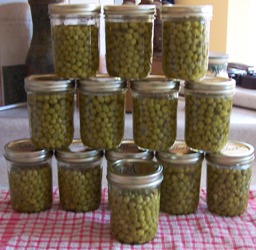Yesterday I received a question from an extension agent about some exploding jars of home canned salsa. The agent said that a new canning enthusiast made the salsa without following a tested recipe, and omitted the addition of vinegar. Vinegar is important in home canned salsa as it lowers the pH and changes the environment so Clostridium botulinum spores can’t germinate and produce toxin. Two weeks later, not only does the dude have a mess in his pantry but he’s also increased the risk that bot toxin has been spewed around his house. 
Not all the jars exploded, just a couple, so the canner wondered if the remaining jars were safe to eat (they aren’t). He didn’t want to throw out the fruits of his labor, but also didn’t want to make people sick, so he checked with the resource person in his county. That’s good.
Botulism problems with home canned products aren’t new at all. Dave Olsen of the Fargo-Moorhead Forum wrote today about a tragic 1931 botulism outbreak that killed 12 people in Grafton ND (that’s fairly close to Canada). The deaths were linked to improperly canned peas that were served at a dinner party hosted by Edward and Delphine Hein.
Delphine served a salad sprinkled with peas she had canned herself.
Within days, 12 people and later a 13th would fall ill and die, including the Heins and three of their six children.
Three Hein children, Richard (Dick), Marvin (Bud) and Wilfred (Bill), were too young to attend the party and spent the evening in their rooms. “That was a lucky break for us,” said Dick Hein, who is now 94 and lives in Detroit Lakes. His brother, Bud, is 84 and lives in Grand Forks. Bill Hein, who was 12 years old when the three brothers missed the party that fateful night, died about five years ago, Bud Hein said.
After the tragedy, the three boys found separate homes with aunts and uncles, though Dick Hein said he soon became restless and moved out to work as a laborer for farmers in the area. Hein, who has three sons of his own, said the parents he lost all those years ago are always near his thoughts, as are two sisters, a brother and a cousin who died from eating the salad.
The two surviving Hein brothers say they had to grow up quickly following their parents’ deaths. A front-page story in the Walsh County Record from Feb. 5, 1931, described the 13 deaths as the worst tragedy in North Dakota’s history. A back-page story quoted a then 14-year-old Dick Hein as asking: “Please, will you see that our mother’s wedding ring is saved so that we will have something to remember her by?”
“If only one of our sisters had lived,” the boy added, “then we could have continued to operate the farm as our father has in the past.”
